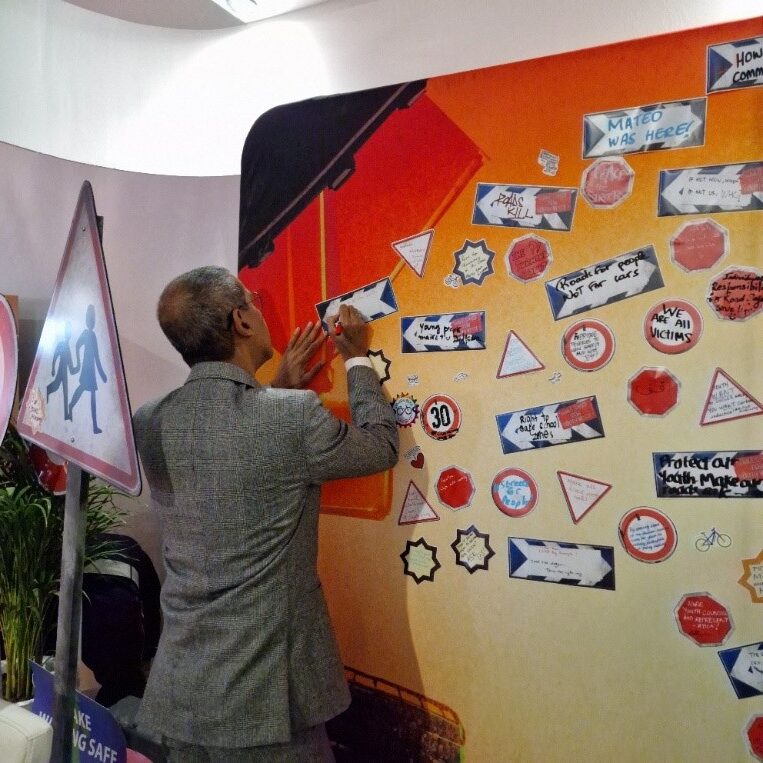
In February 2025, the red city of Marrakech in the Kingdom of Morocco became the epicenter of a renewed global commitment to road safety. Delegates from all walks of life and sectors gathered for the Fourth Global Ministerial Conference on Road Safety, an event that underscored the urgency of addressing a crisis that claims 1.2 million lives every year and leaves another 50 million people injured. The conference clarified that while global road traffic fatalities have declined slightly in recent years, progress has been slow, and the ambitious goal of reducing deaths and injuries by 50% by 2030 remains far from reach.
Youth demand safer roads
A key highlight of the ministerial meeting came from an event that preceded it. The 3rd World Youth Assembly for Road Safety highlighted the power of youth leadership in road safety. Over 200 young leaders from more than 70 countries and their supporters united over two days for a critical mission to call for safer roads for everyone, everywhere. One message reverberated throughout the audience: road traffic crashes are the biggest killer worldwide of young people aged 9-29. As such, young people are the technical experts of their lived experiences and must be involved and engaged in working toward solutions. The Youth Assembly was powerful evidence of the role young leaders play in driving change and saving lives and set the stage for the launch of The Global Youth Statement for Road Safety 2025, which is both a wake-up call and a roadmap for action in youth-led efforts.


The Marrakech Declaration
The conference culminated in leaders adopting the Marrakech Declaration, which seeks to shift global focus towards sustainable, equitable, and urgent road safety solutions. This landmark document is a timely reminder that incremental progress and fragmented actions are insufficient and provides a breakdown of the collective work that remains. It outlines key concerns that need to be addressed immediately, such as the increasing risks faced by vulnerable road users such as pedestrians, cyclists, and motorcyclists and the severe funding gaps for road safety measures, especially in Africa.
It also highlights political commitment as a key enabler of road safety and calls for the political prioritization of road safety within national development strategies. Countries, especially in low—and middle-income regions, are challenged to accelerate their efforts to integrate road safety into broader development agendas and ensure evidence-based policies and sustainable funding models to sustain progress beyond short-term political cycles.
Accepting that meaningful change requires collaboration, the declaration also encourages multisectoral partnerships between governments, businesses, civil society, and international organizations to create a unified approach to road safety. It calls for more global investment and targeted interventions to curb the unacceptably high rate of fatalities in low- and middle-income countries.
The declaration, whose launch was accompanied by the award of the first Mohammed VI International Prize for Road Safety to the World Health Organization and the UN Road Safety Fund (UNRSF), is deeply concerned with the chronic underfunding of road safety programs, particularly in African countries. While most have national road safety plans in place, the issue of implementation remains challenging and unsatisfactory due to inadequate funds and poor enforcement of policies. Public and private investments in road infrastructure are typically for capacity expansion and not road safety. Hence, the roads accommodate more and faster cars but do not ensure the safety of the most vulnerable road user groups like pedestrians, cyclists, and motorcyclists. The declaration calls for increased international financing assistance for low- and middle-income income countries to build safer transport systems.

Africa at the centerstage: A safer future is possible
The continent was in the limelight for several reasons. It was the first time the Global Ministerial Conference on Road Safety was hosted by an African nation, and the event was viewed as a symbolic move towards the continent’s vision and priority for road safety. While the continent has only 4% of the world’s registered vehicles, it accounts for 24% of the world’s road fatalities, making it the region with the highest fatality rate.
The Marrakech Declaration acknowledges these alarming figures and places Africa at the center of the global conversation on road safety. The declaration affirms that a safer future is not just possible; it is a responsibility we must all share. It takes a strong and decisive stand that Africa’s road safety problem must not be seen as the inevitable consequence of development but one that can—and must—be overcome by stronger policies, better financing, and an unyielding commitment to save lives. It represents the turning point towards greater equity in road safety work globally so that solutions are not only developed for more affluent countries but also for the ones that need them most. It calls for sustainable solutions that are tailored to respond to the unique and specific challenges of the continent. The declaration also demands better urban planning with pedestrian-friendly roads, safer public transport, and speed management measures to halt the deaths.
The other key takeaway from the conference was the call for policy harmonization across the continent. With the majority of African countries having antiquated road safety legislation in effect, there is growing pressure for national policies to be benchmarked against international norms. The declaration demands that countries adopt and enact minimum safety standards for vehicles so that imported, and locally assembled vehicles meet the basic requirements.
Another critical issue in Africa addressed by the Marrakech Declaration is the high number of road accident victims who do not receive timely and adequate emergency care. Most regions, particularly the rural ones, have poor trauma care facilities, trained emergency services providers, and functioning ambulances. Post-crash treatment and victim rehabilitation are highlighted as critical priorities that require government investment in emergency systems that have the potential to improve significantly accident survival rates. Alongside government action, the declaration also emphasizes the role played by civil society, the private sector, and community-based organizations in bringing about change. There are already many road safety advocacy groups in the majority of African countries that engage in creating awareness, reforming policies, and supporting road crash victims. Governments are also urged to tap into these organizations and make road safety programs community-based and sensitive to grassroots needs.
What’s next for cities?
Urban areas are home to the highest concentration of pedestrians, cyclists, and motorized vehicles, creating a complex mix of transport interactions. Unfortunately, many cities—especially in low- and middle-income countries—struggle with poorly designed infrastructure, weak enforcement of traffic laws, and inadequate post-crash care. The Marrakech Declaration recognizes these challenges and calls for stronger policies, smarter investments, and a renewed focus on people-centered mobility.
Cities are recognized as the heart of economic and social activity and must also be the center of road safety solutions. One of the key takeaways from the declaration is the urgent need for cities to integrate road safety into urban planning and transport policies. Safer urban streets are not just about reducing crashes but about ensuring that everyone—regardless of age, income, or ability—can move freely and safely. Investments in well-designed pedestrian walkways, protected cycling lanes, efficient public transport, and speed management measures will make roads safer for all. Cities that have successfully implemented these measures, such as Stockholm, Bogotá, and Kigali, have seen notable reductions in road fatalities, proving that change is possible with the right strategies in place.
Beyond infrastructure, the role of multi-stakeholder collaboration, governance, and leadership cannot be overlooked. Cities must establish dedicated road safety agencies, allocate sustainable funding, and commit to data-driven decision-making. Technology also plays a crucial role in shaping safer urban areas. Smart traffic management systems, real-time data collection, and vehicle safety advancements can help prevent crashes and improve emergency response. Cities must embrace innovation while ensuring that safety remains a top priority in the evolution of transport systems.
The Marrakech Declaration provides a global roadmap, but its success depends on local action. Every city has the power to make its streets safer, and by working together, a future where road traffic deaths are no longer an accepted reality is within reach.


